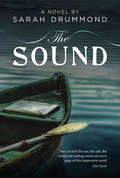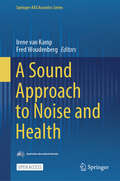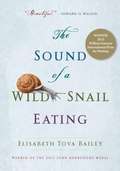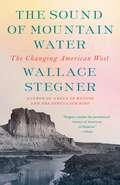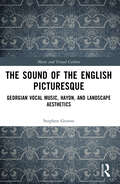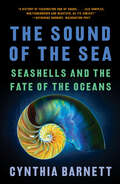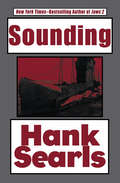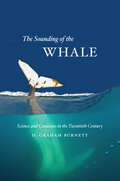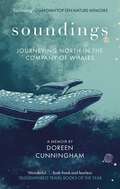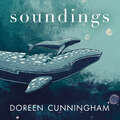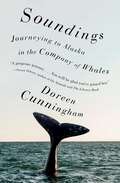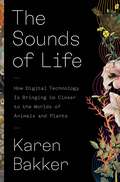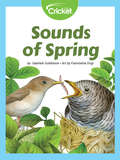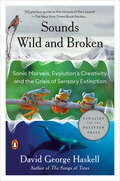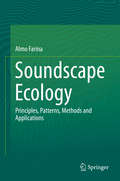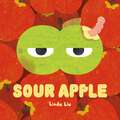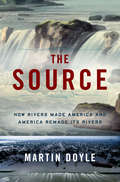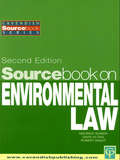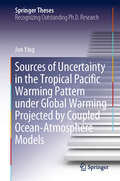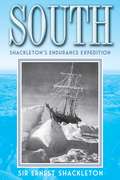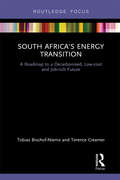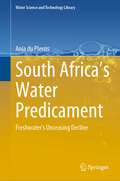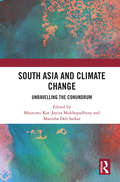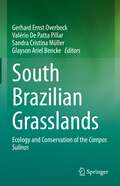- Table View
- List View
The Sound
by Sarah DrummondThe Sound is set in the 1820s, in the violent and lawless world just before the English established colonial law in Western Australia. It is a historical fiction about the men of many nations who made their way across the southern waters of Australia from Tasmania to WA, plundering seal colonies, and stealing women and children from indigenous communities as they went. It follows the journey of Wiremu Heke of Aramoana, who begins his journey on the quest to avenge the destruction of his village, but ends it older, wiser, and looking at the world in an entirely different way.
A Sound Approach to Noise and Health (Springer-AAS Acoustics Series)
by Irene Van Kamp Fred WoudenbergThis open access book highlights the negative and positive health effects of chronic exposure to environmental sound. It describes the state of the art in the field from a public health point of view and puts it in a broad societal perspective looking at sound from physical, social, psychological, economic and governance angles. Rather than a mere collection of papers around the theme as usually provided in special issues, this book offers a comprehensive look at the meaning of sound in society and its impacts and provides directions to further advance the field.
The Sound Of A Wild Snail Eating
by Elisabeth Tova BaileyIn a work that beautifully demonstrates the rewards of closely observing nature, Elisabeth Bailey shares an inspiring and intimate story of her uncommon encounter with a Neohelix albolabris --a common woodland snail. <P><P> While an illness keeps her bedridden, Bailey watches a wild snail that has taken up residence on her nightstand. As a result, she discovers the solace and sense of wonder that this mysterious creature brings and comes to a greater under standing of her own confined place in the world. <P> Intrigued by the snail's molluscan anatomy, cryptic defenses, clear decision making, hydraulic locomotion, and mysterious courtship activities, Bailey becomes an astute and amused observer, providing a candid and engaging look into the curious life of this underappreciated small animal. <P> Told with wit and grace, The Sound of a Wild Snail Eating is a remarkable journey of survival and resilience, showing us how a small part of the natural world illuminates our own human existence and provides an appreciation of what it means to be fully alive.
The Sound of Mountain Water
by Wallace StegnerA book of timeless importance about the American West by a National Book Award and Pulitzer Prize-winning author. Wallace Stegner's essays collected in this volume encompass memoir, nature conservation, history, geography, and literature. Stegner's writing about the West, especially in the wake of the post-World War II boom when much of the Rocky Mountan West--Montana, Wyoming, Colorado, Utah, Idaho, and Nevada--was thrust into the modern age retain their sense of immediacy.Writtten over a period of thirty-five years by a writer and thinker who will always hold a unique position in modern American letters, The Sound of Mountain Water is a modern American classic.
The Sound of the English Picturesque: Georgian Vocal Music, Haydn, and Landscape Aesthetics (Music and Visual Culture)
by Stephen GrovesRevealing the connections between the veneration of national landscape and eighteenth- century English vocal music, this study restores English music’s relationship with the picturesque. In the eighteenth century, the emerging taste for the picturesque was central to British aesthetics, as poets and painters gained popularity by glorifying the local landscape in works concurrent with the emergence of native countryside tourism. Yet English music was seldom discussed as a medium for conveying national scenic beauty. Stephen Groves explores this gap, and shows how secular song, the glee, and national theatre music expressed a uniquely English engagement with landscape. Using an interdisciplinary approach, Groves addresses the apparent ‘silence’ of the English picturesque. The book draws on analysis of the visualisations present in the texts of English vocal music, and their musical treatment, to demonstrate how local composers incorporated celebrations of landscape into their works. The final chapter shows that the English picturesque was a crucial influence on Joseph Haydn’s oratorio The Seasons. Suitable for anyone with an interest in eighteenth- century music, aesthetics, and the natural environment, this book will appeal to a wide range of specialists and non- specialists alike.
The Sound of the Sea: Seashells And The Fate Of The Oceans
by Cynthia BarnettA compelling history of seashells and the animals that make them, revealing what they have to tell us about nature, our changing oceans, and ourselves. Seashells have been the most coveted and collected of nature’s creations since the dawn of humanity. They were money before coins, jewelry before gems, art before canvas. In The Sound of the Sea, acclaimed environmental author Cynthia Barnett blends cultural history and science to trace our long love affair with seashells and the hidden lives of the mollusks that make them. Spiraling out from the great cities of shell that once rose in North America to the warming waters of the Maldives and the slave castles of Ghana, Barnett has created an unforgettable account of the world’s most iconic seashells. She begins with their childhood wonder, unwinds surprising histories like the origin of Shell Oil as a family business importing exotic shells, and charts what shells and the soft animals that build them are telling scientists about our warming, acidifying seas. From the eerie calls of early shell trumpets to the evolutionary miracle of spines and spires and the modern science of carbon capture inspired by shell, Barnett circles to her central point of listening to nature’s wisdom—and acting on what seashells have to say about taking care of each other and our world.
Sounding
by Hank SearlsA New York Times–bestselling author&’s intricately conceived, &“remarkably eloquent&” response to Moby-Dick: a story of harmony between man and whale (The Washington Post). This unique adventure tale follows two characters: one a sonar officer aboard a sinking Russian nuclear submarine; the other a massive, aging sperm whale swimming nearby. As the young man spends what may be his last days with the ship&’s lovely surgeon, he listens to the plaintive calls of the whales sounding—calls of compassion, fear, and anger at humankind&’s attacks on his species. Little does he realize these fellow creatures may also provide his only hope of survival. Giving voice to these magnificent mammals, Hank Searls—who in addition to his work as a writer has also been a yachtsman, underwater photographer, and Navy flyer—taps into our ancient connection to the natural world in a fascinating, suspenseful, and provocative drama.
The Sounding of the Whale: Science and Cetaceans in the Twentieth Century
by D. Graham Burnett&“This wonderful book documents the interplays among science, conservation and politics in the evolving career of the whale over the last century.&” —William Perrin, Senior Scientist for Marine Mammals at the Southwest Fisheries Science Center, NOAA Fisheries Service From biblical times, whales have breached in the human imagination as looming figures of terror, power, confusion, and mystery. In the twentieth century, however, our understanding of and relationship to these superlatives of creation underwent some astonishing changes, and with The Sounding of the Whale, D. Graham Burnett tells the fascinating story of the transformation of cetaceans from grotesque monsters, useful only as wallowing kegs of fat and fertilizer, to playful friends of humanity, bellwethers of environmental devastation, and, finally, totems of the counterculture in the Age of Aquarius. When Burnett opens his story, ignorance reigns: even Nature was misclassifying whales at the turn of the century, and the only biological study of the species was happening in gruesome Arctic slaughterhouses. But in the aftermath of World War I, an international effort to bring rational regulations to the whaling industry led to an explosion of global research—and regulations that, while well-meaning, were quashed, or widely flouted, by whaling nations, the first shot in a battle that continues to this day. The book closes with a look at the remarkable shift in public attitudes toward whales that began in the 1960s, as environmental concerns and new discoveries about whale behavior combined to make whales an object of sentimental concern and public adulation. A sweeping history, grounded in nearly a decade of research, The Sounding of the Whale tells a remarkable story of how science, politics, and simple human wonder intertwined to transform the way we see these behemoths from below.
Soundings: Journeys in the Company of Whales
by Doreen Cunningham'A THRILLING, PASSIONATE AND TENDERHEARTED ADVENTURE' HELEN JUKES, AUTHOR OF A HONEYBEE HEART HAS FIVE OPENINGS'WHAT A VOICE! WHAT A BOOK!' CHARLES FOSTER, AUTHOR OF BEING A HUMAN'BEAUTIFUL AND BRAVE, AND STARTLING IN ITS RAW HONESTY' NEIL ANSELL, AUTHOR OF DEEP COUNTRYFrom the lagoons of Mexico to Arctic glaciers, grey whale mothers are swimming with their calves, past predatory orcas, through a warming sea. For ten thousand miles, they endure one of the longest mammalian migrations on the planet. Following them, by bus, train and ferry, are Doreen Cunningham and her young son Max, in pursuit of a wild hope: that their family of two can make it by themselves.Doreen first visited Utqiagvik, the northernmost town in Alaska, as a young journalist reporting on climate change among indigenous whaling communities. There, she joined the spring whale hunt under the neverending Arctic light, watching for bowhead whales and polar bears, drawn deeply to an Iñupiaq family and their culture amid the disappearing ice.Years later, plunged into sudden poverty and isolation after becoming a single parent, Doreen embarks on an extraordinary journey: following the grey whale migration all the way north to the Iñupiaq family that took her in, where grey and bowhead whales meet at the melting apex of our planet.Soundings is the story of a woman reclaiming her life, mile by mile; a child growing to love an ocean that is profoundly endangered; and a mother learning from another species how to parent in a time of unprecedented change. Intrepid, brave and breathtaking, her travels will take you to the ends of the earth, alongside the whales that call it home.'STUNNING: FRESH, BRAVE AND UNIQUE' DAMIAN LE BAS, AUTHOR OF THE STOPPING PLACES'A BOOK TO BE DEVOURED' RAMITA NAVAI, AUTHOR OF CITY OF LIES'COMPLETELY UNIQUE AND UNFORGETTABLE' ERICA WAGNER'INTIMATE AND FASCINATING' MARK BOYLE, AUTHOR OF THE WAY HOME'BEAUTIFULLY WRITTEN AND GRIPPING' DANIEL LAVELLE, AUTHOR OF DOWN AND OUT'FASCINATING: AN INTIMATE JOURNEY THROUGH A WORLD ALREADY ALTERED BY CLIMATE CHANGE' SJON, AUTHOR OF THE WHISPERING MUSE
Soundings: Journeys in the Company of Whales
by Doreen Cunningham'BEAUTIFUL . . . JUSTIFIES ITS PLACE ALONGSIDE NATURE WRITING CLASSICS SUCH AS H IS FOR HAWK' NEW STATESMAN BEST BOOKS OF 2022'SOUNDINGS GOT UNDER MY SKIN. I FINISHED IT IN TEARS' AMY LIPTROT'STRIKING, BRAVE AND OFTEN LYRICAL' GUARDIAN'WHAT A VOICE! WHAT A BOOK!' CHARLES FOSTER, AUTHOR OF BEING A HUMANFrom the lagoons of Mexico to Arctic glaciers, grey whale mothers are swimming with their calves, past predatory orcas, through a warming sea. For ten thousand miles, they endure one of the longest mammalian migrations on the planet. Following them, by bus, train and ferry, are Doreen Cunningham and her young son Max, in pursuit of a wild hope: that their family of two can make it by themselves.Doreen first visited Utqiagvik, the northernmost town in Alaska, as a young journalist reporting on climate change among indigenous whaling communities. There, she joined the spring whale hunt under the neverending Arctic light, watching for bowhead whales and polar bears, drawn deeply to an Iñupiaq family and their culture amid the disappearing ice.Years later, plunged into sudden poverty and isolation after becoming a single parent, Doreen embarks on an extraordinary journey: following the grey whale migration all the way north to the Iñupiaq family that took her in, where grey and bowhead whales meet at the melting apex of our planet.Soundings is the story of a woman reclaiming her life, mile by mile; a child growing to love an ocean that is profoundly endangered; and a mother learning from another species how to parent in a time of unprecedented change. Intrepid, brave and breathtaking, her travels will take you to the ends of the earth, alongside the whales that call it home.'BEAUTIFUL AND BRAVE, AND STARTLING IN ITS RAW HONESTY' NEIL ANSELL, AUTHOR OF DEEP COUNTRY'STUNNING: FRESH, BRAVE AND UNIQUE' DAMIAN LE BAS, AUTHOR OF THE STOPPING PLACES'A BOOK TO BE DEVOURED' RAMITA NAVAI, AUTHOR OF CITY OF LIES'COMPLETELY UNIQUE AND UNFORGETTABLE' ERICA WAGNER'INTIMATE AND FASCINATING' MARK BOYLE, AUTHOR OF THE WAY HOME'BEAUTIFULLY WRITTEN AND GRIPPING' DANIEL LAVELLE, AUTHOR OF DOWN AND OUT'FASCINATING: AN INTIMATE JOURNEY THROUGH A WORLD ALREADY ALTERED BY CLIMATE CHANGE' SJON, AUTHOR OF THE WHISPERING MUSE
Soundings: Journeys in the Company of Whales: A Memoir
by Doreen Cunningham&“This book is a gorgeous journey…You will be glad you&’ve joined her.&” —Susan Orlean, author of On Animals and The Library Book In this memoir of motherhood, love, and resilience, a woman and her toddler son follow the grey whale migration from Mexico to northernmost Alaska.In this striking blend of nature writing, whale science, and memoir, Doreen Cunningham interweaves two stories: tracking the extraordinary northward migration of the grey whales with a mischievous toddler in tow and living with an Iñupiaq family in Alaska seven years earlier. Throughout the journey she explores the stories of the whales and their young calves—their history, their habits, and their attempts to survive the changes humans have brought to the ocean. Cunningham&’s voice is powerful: sharp, profound, sensitive, and unflinching. A story of courage and resilience, Soundings is about the migrating whales and all we can learn from them as they mother, adapt, and endure, their lives interrupted and threatened by global warming. It is also a riveting journey onto the Arctic Sea ice and into the changing world of Indigenous whale hunters, where Doreen becomes immersed in the ancient values of the Iñupiaq whale hunt and falls in love. For this is Doreen&’s story, too—a fierce, feminist tale, touching on her childhood and her time living in a Women&’s Refuge with her baby, becoming a mother, just like the whales. Lyrical, brave, and fearlessly honest, Soundings is an unforgettable journey.
The Sounds of Life: How Digital Technology Is Bringing Us Closer to the Worlds of Animals and Plants
by Karen BakkerAn amazing journey into the hidden realm of nature&’s soundsThe natural world teems with remarkable conversations, many beyond human hearing range. Scientists are using groundbreaking digital technologies to uncover these astonishing sounds, revealing vibrant communication among our fellow creatures across the Tree of Life.At once meditative and scientific, The Sounds of Life shares fascinating and surprising stories of nonhuman sound, interweaving insights from technological innovation and traditional knowledge. We meet scientists using sound to protect and regenerate endangered species from the Great Barrier Reef to the Arctic and the Amazon. We discover the shocking impacts of noise pollution on both animals and plants. We learn how artificial intelligence can decode nonhuman sounds, and meet the researchers building dictionaries in East African Elephant and Sperm Whalish. At the frontiers of innovation, we explore digitally mediated dialogues with bats and honeybees. Technology often distracts us from nature, but what if it could reconnect us instead?The Sounds of Life offers hope for environmental conservation and affirms humanity&’s relationship with nature in the digital age. After learning about the unsuspected wonders of nature&’s sounds, we will never see walks outdoors in the same way again.
Sounds of Spring
by Gabriele Goldstone Fiammetta DogiWhat sounds do Storks and Cuckoos make in spring? Why do they make these sounds? During the spring months in Ukraine, Cuckoos call to their mates with a beautiful song and Storks use their beaks to make a clacking sound to talk to their mates. Discover how Storks scare predators away with their sounds and how sneaky the Cuckoo bird can be!
Sounds Wild and Broken: Sonic Marvels, Evolution's Creativity, and the Crisis of Sensory Extinction
by David George Haskell&“A symphony, filled with the music of life.&” —Elizabeth Kolbert, author of The Sixth ExtinctionA lyrical exploration of the diverse sounds of our planet, the creative processes that produced these marvels, and the perils that sonic diversity now facesWe live on a planet alive with song, music, and speech. David Haskell explores how these wonders came to be. In rain forests shimmering with insect sound and swamps pulsing with frog calls we learn about evolution&’s creative powers. From birds in the Rocky Mountains and on the streets of Paris, we discover how animals learn their songs and adapt to new environments. Below the waves, we hear our kinship to beings as different as snapping shrimp, toadfish, and whales. In the startlingly divergent sonic vibes of the animals of different continents, we experience the legacies of plate tectonics, the deep history of animal groups and their movements around the world, and the quirks of aesthetic evolution. Starting with the origins of animal song and traversing the whole arc of Earth history, Haskell illuminates and celebrates the emergence of the varied sounds of our world. In mammoth ivory flutes from Paleolithic caves, violins in modern concert halls, and electronic music in earbuds, we learn that human music and language belong within this story of ecology and evolution. Yet we are also destroyers, now silencing or smothering many of the sounds of the living Earth. Haskell takes us to threatened forests, noise-filled oceans, and loud city streets, and shows that sonic crises are not mere losses of sensory ornament. Sound is a generative force, and so the erasure of sonic diversity makes the world less creative, just, and beautiful. The appreciation of the beauty and brokenness of sound is therefore an important guide in today&’s convulsions and crises of change and inequity. Sounds Wild and Broken is an invitation to listen, wonder, belong, and act.
Soundscape Ecology
by Almo FarinaSoundscape Ecology represents a new branch of ecology and it is the result of the integration of different disciplines like Landscape ecology, Bioacoustics, Acoustic ecology, Biosemiotics, etc. The soundscape that is the object of this discipline, is defined as the acoustic context resulting from natural and human originated sounds and it is considered a relevant environmental proxy for animal and human life. With Soundscape Ecology Almo Farina means to offer a new cultural tool to investigate a partially explored component of the environmental complexity. For this he intends to set the principles of this new discipline, to delineate the epistemic domain in which to develop new ideas and theories and to describe the necessary integration with all the other ecological/environmental disciplines. The book is organized in ten chapters. The first two chapters delineate principles and theory of soundscape ecology. Chapters three and four describe the bioacoustic and communication theories. Chapter five is devoted to the human dimension of soundscape. Chapters six to eight regard the major sonic patterns like noise, choruses and vibrations. Chapter nine is devoted to the methods in soundscape ecology and finally chapter ten describes the application of the soundscape analysis.
Sour Apple
by Linda LiuPICK THIS BOOK!(We promise it's sweet.)From the creator of Hidden Gem comes a funny and delightful new picture book about an apple who learns the importance of self-acceptance and patience after being left behind during picking season.Ever been picked last? Well, this sour apple knows a thing or two about what it feels like to be forgotten. When apple season passes and he’s left on the cold, hard ground, he questions his place in the world.As his introspection branches out into different ideas of what could have been if he was chosen, he learns some core truths about what it means to be alive.
The Source: How Rivers Made America And America Remade Its Rivers
by Martin DoyleHow rivers have shaped American politics, economics, and society from the beginnings of the Republic to today. America has more than 250,000 rivers, coursing over more than 3 million miles, connecting the disparate regions of the United States. On a map they can look like the veins, arteries, and capillaries of a continent-wide circulatory system, and in a way they are. Over the course of this nation’s history rivers have served as integral trade routes, borders, passageways, sewers, and sinks. Over the years, based on our shifting needs and values, we have harnessed their power with waterwheels and dams, straightened them for ships, drained them with irrigation canals, set them on fire, and even attempted to restore them. In this fresh and powerful work of environmental history, Martin Doyle tells the epic story of America and its rivers, from the U.S. Constitution’s roots in interstate river navigation, the origins of the Army Corps of Engineers, the discovery of gold in 1848, and the construction of the Hoover Dam and the TVA during the New Deal, to the failure of the levees in Hurricane Katrina and the water wars in the west. Along the way, he explores how rivers have often been the source of arguments at the heart of the American experiment—over federalism, sovereignty and property rights, taxation, regulation, conservation, and development. Through his encounters with experts all over the country—a Mississippi River tugboat captain, an Erie Canal lock operator, a dendrochronologist who can predict the future based on the story trees tell about the past, a western rancher fighting for water rights—Doyle reveals the central role rivers have played in American history—and how vital they are to its future.
Sourcebook on Environmental Law
by Maurice SunkinThe second edition of this sourcebook brings together a comprehensive selection of the principal international, European and domestic sources of environmental law, together with commentary and extensive references to secondary sources (including relevant websites). The new edition has been fully revised and extended to include the major developments in this rapidly evolving area of law. In particular, at the international level there is now consideration of the Kyoto Protocol 1997, the Aarhus Convention 1998, the Basel Protocol 1999 and the Biosafety Protocol 2000. At the European level, there is coverage of the changes introduced by the Amsterdam Treaty; the 2000 Water Framework Directive; the new Air Quality Directives; and the EC White Paper on Environmental Liability. There is also discussion of the proposed Sixth Environmental Action Programme. The domestic coverage includes consideration of the Pollution Prevention and Control Act 1999, the Countryside and Rights of Way Act 2000, the implementation of the contaminated land regime, together with coverage of the new UK waste strategy. The book now also includes extensive consideration of the impact of the Human Rights Act 1998 on environmental law. Recent case law is included throughout. This unique work will provide an extremely valuable resource for all those studying, teaching and working in the field of environmental law.
Sources of Uncertainty in the Tropical Pacific Warming Pattern under Global Warming Projected by Coupled Ocean-Atmosphere Models (Springer Theses)
by Jun YingThis book discusses the sources of uncertainty in future model projections of the tropical Pacific SST warming pattern under global warming. It mainly focuses on cloud radiation feedback and ocean dynamical effect, which reveal to be the two greatest sources of uncertainty in the tropical Pacific SST warming pattern. Moreover, the book presents a correction for model projections of the tropical Pacific SST warming pattern based on the concept of “observational constraints”; the corrected projection exhibits a more El Niño-like warming pattern.
Sources, Sinks and Sustainability
by Jianguo Liu Vanessa Hull Anita T. Morzillo John A. WiensSource-sink theories provide a simple yet powerful framework for understanding how the patterns, processes and dynamics of ecological systems vary and interact over space and time. Integrating multiple research fields, including population biology and landscape ecology, this book presents the latest advances in source-sink theories, methods and applications in the conservation and management of natural resources and biodiversity. The interdisciplinary team of authors uses detailed case studies, innovative field experiments and modeling, and comprehensive syntheses to incorporate source-sink ideas into research and management, and explores how sustainability can be achieved in today's increasingly fragile human-dominated ecosystems. Providing a comprehensive picture of source-sink research as well as tangible applications to real world conservation issues, this book is ideal for graduate students, researchers, natural-resource managers and policy makers.
South: Shackleton's Endurance Expedition (Barnes and Noble Digital Library)
by Ernest ShackletonIn 1914, as Europe braces for an unfathomably deadly war, explorer Sir Ernest Shackleton sets sail for Antarctica to do the impossible: traverse the continent. He has a ship (the aptly named Endurance), a head brimming with optimism, and 28 men willing to follow him on an expedition across some of the most treacherous terrain on the planet. But Shackleton's optimism doesn't last long. Despite his experience in the Antarctic, disaster strikes early on when the Endurance is trapped in packed ice and slowly crushed, forcing Shackleton and his men off the ship and stranding them in a sea of ice. South is the legendary story of Shackleton and his crew's struggle to survive the elements and return home alive. Written by Shackleton, South is a truly astonishing story of human fortitude. It is the story of a voyage that lasts nearly three years-a firsthand account of hurricane-force winds, subzero temperatures, glaciers, icebergs, freezing water, starvation, and lethal, terrifying storms. It is a tale unlike any to come before or since. Shackleton's record of his journey made him famous around the world and transformed him into a symbol of achievement and hope in an age of darkness and war.
South Africa’s Energy Transition: A Roadmap to a Decarbonised, Low-cost and Job-rich Future (Routledge Focus on Environment and Sustainability)
by Tobias Bischof-Niemz Terence CreamerSouth Africa’s energy transition has become a highly topical, emotive and politically contentious topic. Taking a systems perspective, this book offers an evidence-based roadmap for such a transition and debunks many of the myths raised about the risks of a renewable-energy-led electricity mix. Owing to its formidable solar and wind resources, South Africa has an almost unparalleled opportunity to turn solar photovoltaic and onshore wind generators into the country’s power generation workhorses – a role hitherto played by coal. This book shows that a renewables-led mix will not only provide the lowest cost, but will also create more jobs than any of the alternatives currently under consideration. In addition, it offers a glimpse of how South Africa’s low-cost and decarbonised electricity system can power a competitive industrial economy, an electric-mobility revolution and, in the long run, create new export opportunities. This book will be of great interest to energy industry practitioners, as well as students and scholars of energy policy and politics, environmental economics and sustainable development.
South Africa’s Water Predicament: Freshwater’s Unceasing Decline (Water Science and Technology Library #101)
by Anja du PlessisThe book provides a critical evaluation of South Africa’s freshwater resources to illustrate the way in which its freshwater resources, water access, services and infrastructure have continued to decline over the past three decades. The continued decline of water governance, management, water service delivery, dilapidated water infrastructure, dysfunctional local governments and overall excessive water degradation is illustrated and emphasized using real-life examples and case studies from various contexts within the country.The main argument of the book is that South Africa’s freshwater resources have declined to such an extent that it can be described as a predicament. Questionable water governance decisions and reactive water management practices have led to no improvement and/or increased degradation of freshwater resources. An overall lack of service delivery exists across the country, in various contexts, leading to further water and social decline.An inter-disciplinary evaluation of South Africa’s current water predicament is provided, major water crises are prioritized, and suitable recommendations are given to transform its predicament into problems which can be addressed. Suitable background information is given to emphasize the necessity of good water governance, management, and service delivery. South Africa’s freshwater resources are evaluated with specific focus on the decline of informed water governance, management, service delivery and water quality. Factors requiring urgent attention are determined and suitable recommendations and/or actions are provided.An evaluation and overall synthesis focused on the transformation of the predicament into problems is provided. Primary water problems are prioritized according to urgency and suitable recommendations are given to assist in transforming the country’s current complex water predicament into “simpler” water problems. Political will, collaboration with researchers, stakeholders, non-governmental organizations, and cooperation of civil society is required.South Africa’s already scarce freshwater resources and decaying infrastructure will persist and possibly collapse if no major actions or interventions are implemented.
South Asia and Climate Change: Unravelling the Conundrum
by Mausumi Kar; Jayita Mukhopadhyay; Manisha Deb SarkarThis book provides a comprehensive and interdisciplinary examination of the diverse aspects of climate change in South Asia. The region, home to almost 4% of the world’s population, is under serious threat from climatic disasters. The volume underscores the urgency of addressing cataclysmic events related to climate change and their ramifications on the economy, agriculture and livelihoods of the region. The book discusses the reasons causing climate change as well as highlights normative and ethical considerations involved in the battle against climate change. With case studies from India, Sri Lanka and Bangladesh, it explores issues such as extreme climatic events; energy use, fossil fuels, non-renewable resources and carbon dioxide emission in South Asia; internal migration and climate refugees; the ethical dilemma of sustainable development; technological advancements for extreme weather forecast; and responses to climate change in South Asia. Highlighting the need for striking a balance between developmental imperatives and environmental sustainability, the chapters also show the North-South divide in the research agenda and policies on climate change and the global politics that underlie climate policies. The volume juxtaposes a scientific analysis of factors responsible for climate change with an analysis of the human cost of climate change from the perspective of social sciences. It discusses the challenges faced by developing countries while also offering recommendations and solutions. This book will be of interest to scholars and researchers of climate studies, geography, public policy and governance, sustainable development, development studies, environmental studies, political studies, international relations, political economy, economics and sociology. It will also be useful to practitioners, thinktanks, policymakers and civil society organisations working on environmental management.
South Brazilian Grasslands: Ecology and Conservation of the Campos Sulinos
by Gerhard Ernst Overbeck Valério De Patta Pillar Sandra Cristina Müller Glayson Ariel BenckeThis volume explores the South Brazilian grasslands, a unique complex of ecosystems in Brazil. Despite high biodiversity and many important ecosystem services, their biodiversity and conservation are neglected, both nationally, and globally. This book provides a state-of-the-art synthesis of knowledge on the biodiversity and its drivers in South Brazilian grasslands and associated ecosystems. Further, the book discusses conservation challenges and options, as well as management strategies that help to maintain the region’s uniqueness. The chapters present information on biodiversity and ecological features of the region, and put this information into the context of historical and current human land uses, allowing for links to global discussions of conservation and sustainable development. Altogether, the book contains 20 chapters organized in four sections. The book is directed at researchers, students and professionals working with biodiversity and sustainable development in southern Brazil, as well as to the international scientific and conservation community interested in grasslands and associated ecosystems, particularly in tropical and subtropical regions.
